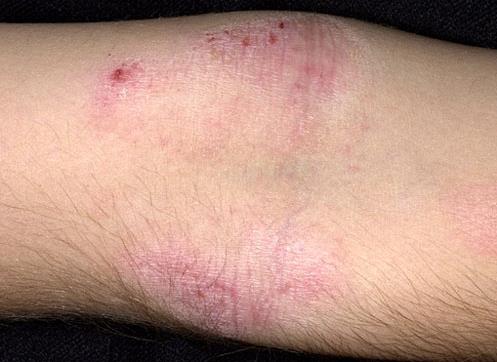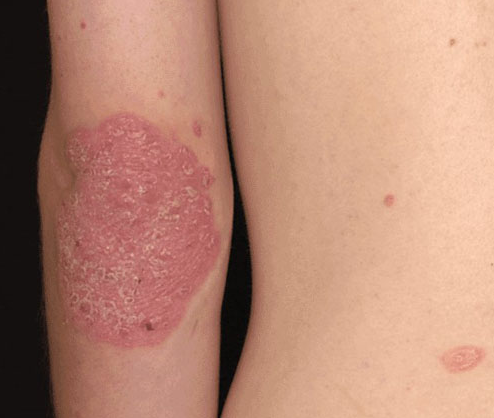Atopic dermatitis
OVERVIEW
What is atopic dermatitis?
Atopic dermatitis, also known as atopic eczema or hereditary allergic eczema, is now more commonly referred to as atopic dermatitis (AD). It is a chronic, recurrent, inflammatory, and pruritic skin condition and one of the most common diseases in dermatology.
It is characterized by two prominent features: dry skin and intense itching. Patients experience impaired skin barrier function, and due to the severe itching, the condition often significantly impacts their work and quality of life.
Atopic dermatitis is not just a skin disease but also a systemic disorder. Some patients may also suffer from other allergic conditions such as asthma or allergic rhinitis.
What is the "atopy" in atopic dermatitis?
In addition to typical skin manifestations, atopic dermatitis exhibits distinct "atopic" characteristics:
-
Personal/family history of atopic diseases (including eczema, allergic rhinitis, asthma, allergic conjunctivitis, etc.);
-
Elevated serum total IgE (immunoglobulin E) and/or increased peripheral blood eosinophils and/or positive allergen tests (allergen-specific IgE level 2 or higher).
Is atopic dermatitis common?
Atopic dermatitis most frequently occurs in children but can also affect adults. Globally, 5%–20% of children are affected, with the majority of cases developing before the age of 5. About 50% of children diagnosed with atopic dermatitis may continue to experience symptoms into adulthood.
The disease can occur in any race or region, but the incidence appears higher in urban and developed areas.
SYMPTOMS
What are the common manifestations of atopic dermatitis?
The primary signs of atopic dermatitis are dry skin and intense itching, often accompanied by chronic eczematous skin lesions.
However, its clinical manifestations vary significantly depending on the patient's age and disease activity. Main symptoms include: severe itching, redness, small raised bumps, dry skin, flaking, or scaling. The skin may thicken and darken, and excessive scratching can even lead to scarring.

Where does atopic dermatitis commonly occur?
The distribution of eczema varies among different age groups:
-
In infants, it often appears on the cheeks, forehead, and scalp.
-
In children, it frequently affects the elbow creases, knee creases, and the outer sides of the legs.
-
In adolescents and adults, it primarily occurs in the elbow creases, knee creases, and front of the neck, but may also appear on the trunk, limbs, face, and back of the hands.
How is atopic dermatitis staged?
Atopic dermatitis is generally divided into three stages: infantile, childhood, and adolescent/adult.
-
Infantile stage (birth to 2 years): Presents as infantile eczema, mostly on the cheeks, forehead, and scalp. The rash may be dry or oozing.
-
Childhood stage (2 to 12 years): Often develops from the infantile stage but may also appear without prior symptoms. It commonly affects the flexural areas of the limbs, particularly the elbow and knee creases, with subacute and chronic dermatitis as the main manifestations.
-
Adolescent and adult stage (12 years and older): Skin lesions resemble those in childhood, mainly appearing in the elbow creases, knee creases, and front of the neck. Subacute and chronic dermatitis dominate, with most cases presenting as dry, thickened dermatitis.
CAUSES
Why does atopic dermatitis occur?
The onset of atopic dermatitis is closely related to genetic and environmental factors. Many causes, including congenital skin barrier abnormalities, defects in innate immune responses, and changes in skin-resident microbial flora, can lead to the disease.
Who is prone to atopic dermatitis?
People with a family history of atopic dermatitis, asthma, or allergic rhinitis are more likely to develop atopic dermatitis. Those with loss-of-function mutations in the filaggrin gene (FLG), which affects skin barrier function, are also susceptible. It most commonly occurs in children but can also affect adults.
Is atopic dermatitis contagious?
No.
Is atopic dermatitis hereditary?
Yes.
Atopic dermatitis has a clear genetic predisposition. Individuals with relatives who have eczema, atopic dermatitis, allergic rhinitis, asthma, or allergic conjunctivitis have a significantly higher risk of developing the condition.
DIAGNOSIS
How is atopic dermatitis diagnosed?
When diagnosing atopic dermatitis, doctors base their assessment on medical history, the appearance and distribution of skin lesions, and related clinical symptoms. In addition to symptoms of skin itching, the diagnosis must also meet atopic characteristics.
Which diseases is atopic dermatitis easily confused with?
Atopic dermatitis can be distinguished from seborrheic dermatitis, psoriasis, and heat rash. However, a specific diagnosis should be made by a specialist, and self-medication should be avoided to prevent delaying treatment.
How to differentiate between atopic dermatitis and seborrheic dermatitis?

Seborrheic dermatitis and atopic dermatitis may coexist. Sometimes, seborrheic dermatitis is actually a manifestation of atopic dermatitis. However, the presence of orange-red skin erythema with greasy scales, involvement of the scalp, and minimal or no itching supports a diagnosis of seborrheic dermatitis.
How to differentiate between atopic dermatitis and psoriasis?

In infants and young children, psoriasis often affects the diaper area, presenting as well-defined erythema with minimal scaling, whereas atopic dermatitis does not involve the diaper area.
Are there targeted tests for atopic dermatitis?
No. However, doctors can determine the presence of atopic dermatitis by examining the skin and asking relevant questions.
TREATMENT
Which department should I visit for atopic dermatitis?
Dermatology.
Can atopic dermatitis heal on its own?
Patients with mild atopic dermatitis may experience intermittent flare-ups and spontaneous remission, but moderate to severe cases rarely resolve without treatment.
How is atopic dermatitis treated?
The optimal treatment requires a multifaceted approach, including eliminating aggravating factors, restoring skin barrier function, maintaining skin hydration, patient education, and using medications to reduce skin inflammation and alleviate symptoms—though it cannot be cured. Even so, about half of affected children outgrow the condition by adulthood.
What are the treatment measures for atopic dermatitis?
Atopic dermatitis is typically managed using a stepwise approach, with treatment strategies varying based on severity (mild, moderate, or severe).
Basic treatment is the first step, such as moisturizing, avoiding irritants, and identifying triggers. Depending on the severity of lesions, topical medications (e.g., antihistamines) may be prescribed for mild to moderate cases. Severe cases require systemic therapy, supplemented with topical treatments and phototherapy.
- Moisturizers and bathing: Help maintain skin hydration, a critical part of overall treatment.
- Topical medications: Include corticosteroids, calcineurin inhibitors, and antimicrobial agents for infections.
- Systemic medications: Include antihistamines, anti-inflammatory drugs, antibiotics, corticosteroids, immunosuppressants, and others like glycyrrhizin, calcium, and probiotics.
- Immunotherapy (desensitization).
- Phototherapy: Involves exposure to specific ultraviolet wavelengths in a clinical setting, mainly for moderate to severe cases. Long-term use may increase skin cancer risk.
What medications can be used for atopic dermatitis?
Specific medications should be prescribed by a doctor based on individual conditions.
- Topical medications:
- Corticosteroids (e.g., dexamethasone cream) and calcineurin inhibitors (e.g., pimecrolimus cream).
- For secondary infections, antimicrobial agents like mupirocin ointment may be used.
- Systemic medications:
- Include antihistamines (e.g., fexofenadine, loratadine, cetirizine), antibiotics, corticosteroids, immunosuppressants, and biologics.
- Oral corticosteroids are reserved for severe, uncontrolled cases.
- Immunosuppressants (e.g., cyclosporine, azathioprine) may be used for refractory cases, with close monitoring of blood tests and liver function.
Is hospitalization required for atopic dermatitis?
Generally not, but moderate to severe cases or those with skin infections should seek medical care.
How do moderate and severe atopic dermatitis differ?
Assessment methods vary. Below is a guideline from the UK National Institute for Health and Care Excellence:
- Moderate: Localized dryness, frequent itching, redness (with or without scratching-induced lesions/thickening); moderate impact on daily life and sleep.
- Severe: Widespread dryness, persistent itching, redness (with or without extensive thickening, bleeding, oozing, cracking, or pigmentation changes); severe limitations in daily activities and sleep disruption.
DIET & LIFESTYLE
What should patients with atopic dermatitis pay attention to in their diet?
-
Avoid alcohol and spicy foods;
-
Some patients are allergic to milk, eggs, fish, wheat, peanuts, and soybeans. Pay attention to whether dermatitis and itching worsen after consuming protein-rich foods. If certain foods aggravate symptoms, avoid them; if necessary, conduct a food elimination-provocation test under medical guidance.
What should patients with atopic dermatitis pay attention to in daily life?
-
Apply moisturizer immediately after bathing while the skin is still hydrated. The moisturizer should preferably contain glycyrrhetinic acid, glycerin, or urea;
-
Keep nails short to avoid unintentional scratching and skin damage; avoid excessive bathing and refrain from using soap or harsh cleansers;
-
Avoid irritants and strong odors such as perfume, fragrances, mosquito coils, mothballs, and pesticides;
-
Wear loose cotton clothing and avoid wool or synthetic fabrics; avoid contact with animal fur, excrement, etc.;
-
Avoid carpets, straw mats, and plush toys;
-
Avoid strong sunlight and excessive sweating, as both can irritate the skin;
-
Clean bedding weekly at high temperatures to reduce bacterial contamination;
-
Keep the environment as clean as possible to minimize dust, maintain humidity between 40%–60%, avoid excessive dryness, and prevent large temperature fluctuations. Use an air purifier to reduce bacteria;
-
Reduce emotional fluctuations and stress, and avoid secondhand smoke;
-
Carefully treat any skin wounds to prevent infection.
PREVENTION
Can atopic dermatitis be prevented? How to prevent it?
Maybe.
Infants with parents, siblings, or sisters who have atopic dermatitis are also at higher risk of developing the condition. For these infants, strengthening the skin barrier with moisturizing creams or ointments (starting immediately after birth) may help prevent the onset of atopic dermatitis during the first year of life. However, it is still unclear whether this measure can also help prevent atopic dermatitis later in life.
How to prevent recurrence of atopic dermatitis?
Atopic dermatitis often recurs. Skin moisturizing and reducing or eliminating allergens may help reduce its recurrence.